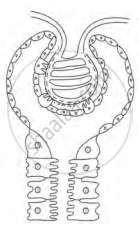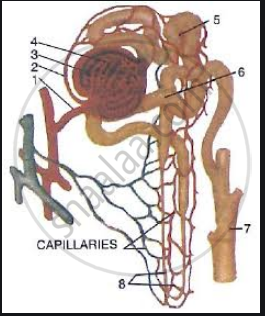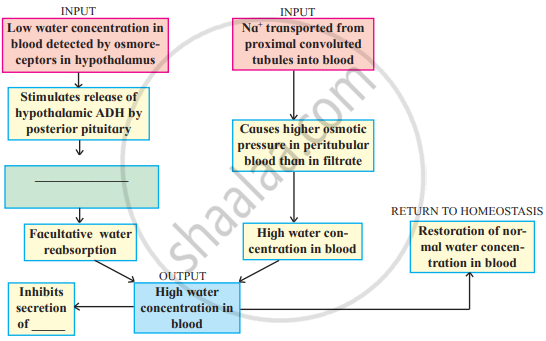Advertisements
Advertisements
प्रश्न
Complete the diagram/chart with correct labels/ information. Write the conceptual details regarding it.

उत्तर
Malpighian body-

Nephron is the structural and functional unit of kidney.
Malpighian body: Each Malpighian body is about 200μm in diameter and consists of a Bowman’s capsule and glomerulus.
- Glomerulus:
Glomerulus is a bunch of fine blood capillaries located in the cavity of Bowman’s capsule. A small terminal branch of the renal artery, called as afferent arteriole enters the cup cavity (Bowman capsule) and undergoes extensive fine branching to form network of several capillaries. This bunch is called as glomerulus. The capillary wall is fenestrated (perforated). All capillaries reunite and form an efferent arteriole that leaves the cup cavity. The diameter of the afferent arteriole is greater than the efferent arteriole. This creates a high hydrostatic pressure essential for ultrafiltration, in the glomerulus. - Bowman’s capsule:
It is a cup-like structure having double walls composed of squamous epithelium. The outer wall is called as parietal wall and the inner wall is called as visceral wall. The parietal wall is thin consisting of simple squamous epithelium. There is a space called as capsular space / urinary space in between two walls. Visceral wall consists of special type of squamous cells called podocytes having a foot-like pedicel. These podocytes are in close contact with the walls of capillaries of glomerulus. There are small slits called as filtration slits in between adjacent podocytes.
APPEARS IN
संबंधित प्रश्न
Describe the structure and functioning of nephrons.
What is the role of glomerulus in the kidney?
Explain the principle of dialysis with the help of a labelled diagram.
Choose the odd one out in the following series:
Renal fat, renal capsule, nerve.
The following diagram represents a mammalian kidney tubule (nephron) and its blood supply.

Parts indicated by the guidelines 1to 8 are as follows:
1. Afferent arteriole from renal artery
2. Efferent arteriole
3. Bowman's capsule
4. Glomerulus
5. Proximal convoluted tubule with blood capillaries
6. Distal convoluted tubule with blood capillaries
7. Collecting tubule
8. U-shaped loop of Henle
Study the diagram and answer the question that follow:
Which structure (normally) contains the lowest concentration of glucose?
Differentiate between:
Ureter and Urethra.
Complete the following sentence with appropriate word:
The sum total of all the chemical reactions taking place in the cell is known as ______.
State the Location: Renal pyramids
Answer the following question.
Name any one guanotelic organism.
Complete the diagram/chart with correct labels/ information. Write the conceptual details regarding it.

